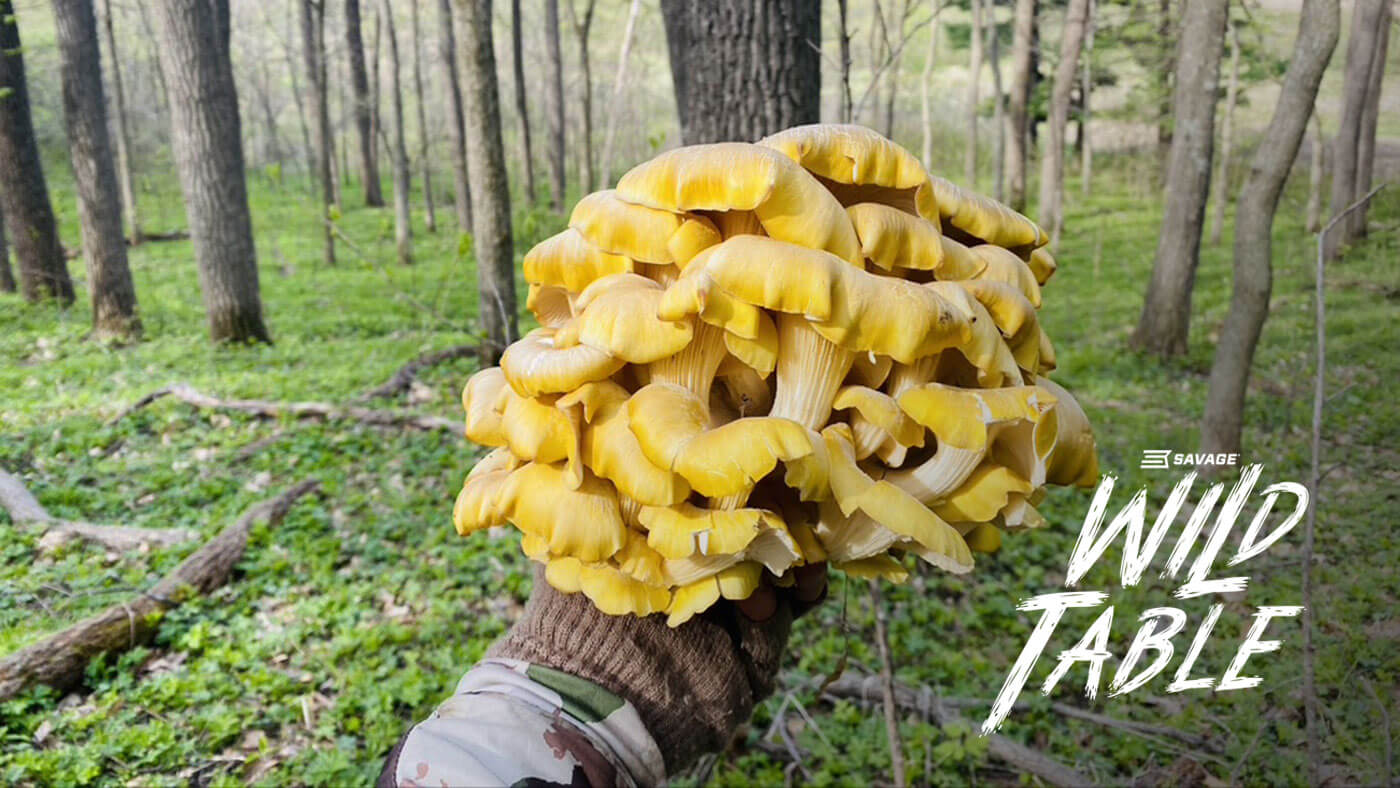- Savage Blog
- Foraging Oyster Mushrooms | Wild Table
Foraging Oyster Mushrooms | Wild Table

The temperatures are warming, days are getting longer, and you can begin to smell the change of the seasons from winter to spring wafting in the air. This time of year brings the forest back to life and it gets me excited to be out foraging the areas I had scouted during the winter months in anticipation of fresh wild food to be growing. There is a certain aspect of foraging that reminds me of hunting: putting in the effort to scout areas for the potential of mushrooms fruiting or other edible plants, is a parallel approach to scouting for the animals we hunt. The time put in often rewards us with a bounty of meals to come. It's a symbiotic relationship between these activities and the two food sources often pair flavorfully together.
One of my favorite fungi, the oyster mushroom, is busily fruiting again in the Pacific Northwest. Although Spring is when they are most prolific here, you can often find them throughout the year. Unlike morel mushrooms, that like to hide when you are searching for them, oyster mushroom fungi are incredibly easy to find once you know how they tick. Appreciated by foragers for their versatile culinary uses, valued for their meaty texture coupled with a subtle earthy & anise flavor, these fungi become the perfect addition to any meal.

As with identifying any fungi you want to consume, never (EVER) consume a wild mushroom if you aren’t 100% certain of its identity. Like the saying goes, “Advice is like mushrooms. The wrong kind can prove fatal.” -Charles E McKenzie
Identifying & Harvesting
Pleurotus ostreatus (oyster mushrooms) are saprotrophic, meaning they are one the great decomposers of the fungi kingdom that break down dead wood. Thus, you’ll always find them growing on rotting or dying timber- never in soil. They often inhabit moist, mixed woods in riparian areas - in bogs and along streams. Oysters are also one of the few carnivorous mushrooms. Simply put, the mycelia of these mushrooms are capable of killing and digesting nematodes. Cool, right?

Though location may vary, look for them on fallen trees, stumps, or standing dying trees. As their name suggests, these fungi look like bivalves growing from logs. Unlike their namesakes, however, they have well-defined wavey gills, which is one of the first things you should look at when identifying this mushroom- the presence of what is called decurrent gills. Decurrent means that the gills are attached to and run directly down the stem. Look closely at the picture above. Can you see how they run into and down the stem? They are also known for its oyster shaped cap and an off-center, short (or absent) stem. The caps are typically anywhere from two to ten inches across and are generally white to light brown (some may say similar to the color of oysters), though different parts of the country have different varieties- like the golden oyster that has a vibrant and beautiful yellow cap, but still have the same distinct gills.

You’ll typically spot oyster mushrooms growing in shelf-like clusters with individual mushrooms overlapping. The tops of the mushrooms should be smooth and free from warts or scales. Inspect the skin of mushrooms: If the texture of oyster mushrooms feels slimy or damp, then leave these mushrooms to decompose. Fresh mushrooms usually feel dry and have firm skin with a soft, sponge like flesh. Stale mushrooms on the other hand, will have a hard, dry, and brittle texture. Oyster mushrooms are characterized by a white, or lilac-gray spore print (use a dark background for this) and offer a faint smell that resembles anise- like when they are cooked. When harvesting these mushrooms, cut them close to the base of their stems, leaving just a little on the stump. I encourage you to take only what you will use- think sustainable harvesting. Leave some for the next person and for them to spread their spores to possibly grow back the next year!
Cleaning, Eating, and Preserving
On to what to do with that decadent harvest you have collected!
Oyster mushrooms are like sponges, which is why I personally never wash these mushrooms. I use a soft brush or cloth to clean off any bits of dirt. I usually trim off a smidge of their stems at this point and inspect for any worms that may be in them. Toss any that you may question. When you slice into an oyster mushroom, the flesh should feel firm and the interior flesh is generally white.
I have been extremely fortunate to find an abundance of these mushrooms, so I have a few methods of preservation!
One of my favorite meals is freshly harvested oyster mushrooms sauteed in lard with a little salt & pepper. Incredibly simple, so I can savor all the flavors these mushrooms share with my tastebuds. I slice or tear the mushrooms into roughly 1-inch pieces (you can also leave them larger, but they may take a little longer to cook) and toss them into a pre-heated pan over medium heat with lard, butter or oil of your choice. I sprinkle a little salt & pepper over the top, then toss them around for 5-10 minutes, stirring frequently so they don’t stick to your pan. I personally like mine a little on the crunchy side and paired with venison backstrap!
If I happen to stumble upon a big cluster of oyster mushrooms this is simple mushroom marinade recipe that I enjoy:
Grilled Honey Oyster Mushrooms
Ingredients:
- 1 LB oyster mushrooms left in clusters
- ¼ CUP soy sauce
- 4 TBSP garlic infused honey
- 2 fresh cloves garlic chopped
- 1 TSP grated ginger
- Pepper to taste
Cooking Method:
- Turn on grill and heat grill pan
- Combine, soy sauce, honey, garlic ginger and pepper. Marinate mushrooms for 15 minutes
- Grill mushrooms on both sides until slightly charred; serve immediately
If you don’t plan on using your mushrooms right away, the best way to store them is in a paper bag in your fridge. They will typically last roughly a week this way. Here are a few methods if you want to enjoy them for a little longer when your season has ended.
Freezing:
Freezing is a great option if you plan on eating them in approximately a month’s time. They can be frozen, either raw, or in their cooked state, as long as they are stored in an airtight container or a freezer bag. I have kept some frozen for close to six months when I have vacuumed sealed them.
Canning:
Pickling oyster mushrooms is another great way to preserve them. Not only does this method allow them to be stored for a longer period, but this also turns them into great toppings on burgers, sandwiches, or just enjoy like any other pickled food. Choses your favorite pickling recipe for this method and substitute the cucumber for mushrooms!

Dehydrating:
This is hands down my favorite way for a couple of reasons. First, because I love admiring my jars of mushrooms in my pantry, second because it is a great way to have fungi available at my fingertips, but really the main reason is because they are a versatile food source that can be used in a multitude of recipes. Depending on your method of dehydrating, you can slice them into pieces or leave them whole. I leave mine whole.
- Arrange mushrooms in a single layer on trays leaving space for air flow
- Dehydrate at 125F(52C) for 5-10 hours, or until the mushrooms are completely dry. They should be brittle & break, not bend when fully dry
- Store in a sanitized, airtight, glass jar for up to six months in a cool area and out of sunlight

You can also use your oven (this method I recommend slicing):
- Arrange mushrooms in a single layer on a baking sheet in single layers
- Preheat oven to 150F(60C)
- Cook for one hour
- Flip mushrooms and cook for an additional hour or until the mushrooms are completely dry
- Store in a sanitized, airtight, glass jar for up to six months in a cool area and out of sunlight
There is no need to rehydrate these mushrooms, as they will soak up other fluids like a sponge and won’t become mushy! Here are some ways to use your dehydrated mushrooms:
- Use them in your favorite stir fry
- Toss them in your favorite soups, or sauces for some additional flavor
- Grind up some of your dehydrated mushrooms in a coffee grinder and use them to make seasonings, rubs or sprinkle over a meal. I love this little addition on my salads!
One cup of sliced & raw oyster mushrooms has approximately 28 calories, 5 grams of carbohydrates, less than 1 gram of fat, and about 3 grams of protein. Oyster mushrooms are also an excellent source of niacin, fiber, and riboflavin.
Enjoy!

Are you a field to table foodie? Check out more of our wild game recipes and foraging tips on our Wild Table blog!

